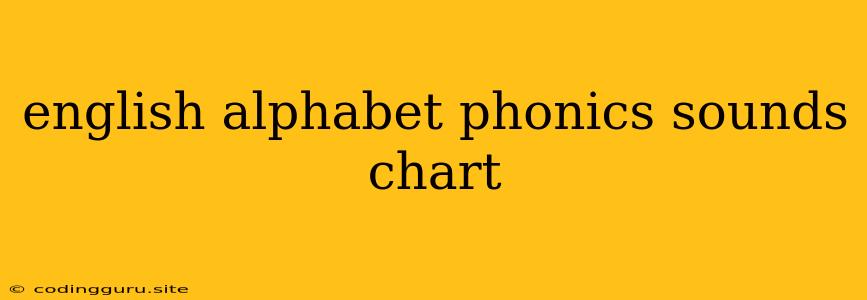Dive into the World of English Sounds with a Phonics Chart
Learning to read and write in English can feel daunting, especially with the language's seemingly complex spelling system. But fear not! Understanding the English alphabet phonics sounds chart can unlock the door to fluent reading and writing.
What is a phonics chart? In essence, it's a visual representation of the English alphabet and the sounds each letter or letter combination makes. It's a powerful tool for both learners and teachers, acting as a bridge between letters on the page and the sounds they produce.
Why is a phonics chart so helpful? Imagine trying to learn a new language without knowing the pronunciation of the words. That's where a phonics chart steps in. It gives you a foundation for decoding words by connecting the letters to their sounds.
Navigating the Phonics Chart: Key Elements
A typical English alphabet phonics sounds chart will feature the 26 letters of the alphabet, categorized as vowels and consonants.
Vowels: The heart of English pronunciation! They are the open sounds that we make when we allow air to flow freely through our mouths.
- Short vowels (e.g., 'a' in "cat", 'e' in "bed", 'i' in "pig", 'o' in "hot", 'u' in "cup")
- Long vowels (e.g., 'a' in "cake", 'e' in "see", 'i' in "bike", 'o' in "go", 'u' in "cube")
- Diphthongs: These are combinations of two vowel sounds blended together (e.g., "oi" in "oil", "ou" in "house")
Consonants: These are sounds made by partially blocking the airflow from our mouths.
- Single consonants: Like 'b', 'd', 'f', 'g', 'h', 'j', 'k', 'l', 'm', 'n', 'p', 'q', 'r', 's', 't', 'v', 'w', 'x', 'y', 'z'
- Digraphs: Combinations of two consonants that make a single sound (e.g., 'sh' in "ship", 'ch' in "chair")
Understanding the Sounds:
- Phonemes: Each distinct sound in the English language is called a phoneme.
- Graphemes: The letter or letter combination that represents a phoneme is called a grapheme.
- Phonetic Transcription: A phonics chart will often include phonetic transcriptions using the International Phonetic Alphabet (IPA) to represent each sound.
Using the Phonics Chart:
1. Familiarize Yourself: Spend time looking at the English alphabet phonics sounds chart and memorizing the sounds associated with each letter and combination. 2. Practice Regularly: Use the chart as a reference point for decoding words and practice reading aloud. 3. Break Down Words: When you encounter an unfamiliar word, try to break it down into individual sounds or sound combinations using the chart. 4. Be Patient and Persistent: Learning phonics takes time and practice. Don't get discouraged if you don't grasp it immediately!
Beyond the Basics: Expanding Your Phonics Knowledge
- Silent Letters: Certain letters in words are sometimes silent, meaning they don't produce any sound (e.g., 'k' in 'knife').
- Vowel Teams: Combinations of vowels can create different sounds (e.g., "ai" in "rain", "ea" in "bread").
- Consonant Blends: Two consonants that are pronounced together (e.g., "bl" in "blue", "st" in "stop").
Benefits of Using a Phonics Chart:
- Improved Reading: Understanding phonics allows you to decode unfamiliar words and read fluently.
- Enhanced Spelling: Knowing the sounds of letters helps you spell correctly.
- Stronger Language Foundation: Phonics forms the basis of literacy, helping you understand the structure of English and how it works.
- Fun and Engaging: Learning phonics can be an enjoyable process with the right approach and resources.
Conclusion
The English alphabet phonics sounds chart is a valuable tool for anyone looking to improve their reading and writing skills. By understanding the sounds associated with letters and letter combinations, you can unlock the power of English and enjoy the joy of reading and writing. Remember, practice is key! So dive into the world of phonics and watch your language skills soar!
